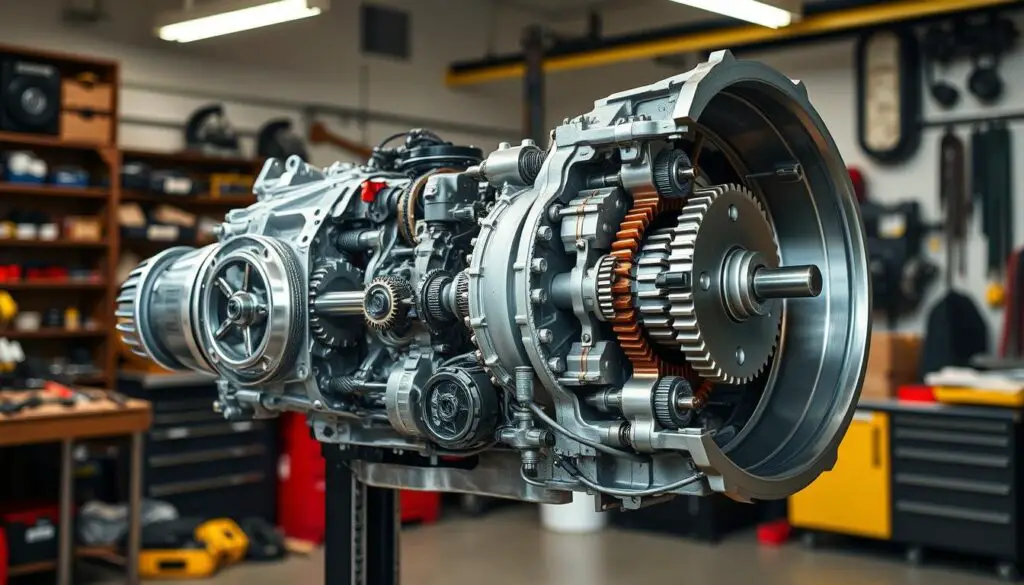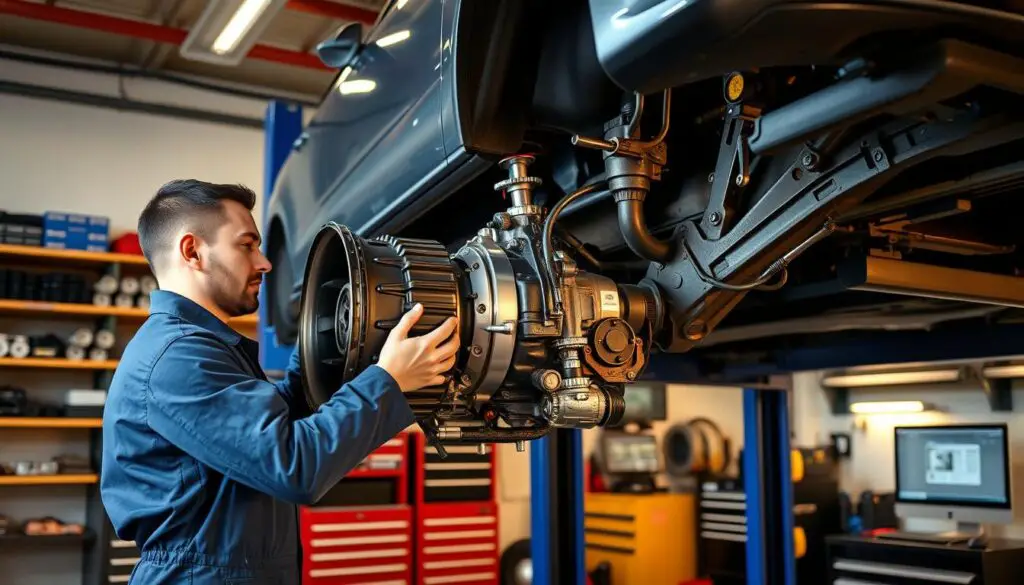Modern vehicles rely heavily on sophisticated automatic transmissions to ensure smooth and efficient gear shifting. However, when an automatic transmission fails to shift into high gear, it can lead to decreased performance, reduced fuel efficiency, and potentially cause further damage to the vehicle.
Understanding the underlying causes of transmission shifting problems is crucial for effective transmission repair. This article aims to provide a comprehensive overview of the common reasons behind an automatic transmission’s failure to shift into high gear and offer practical solutions for diagnosis and repair.
Key Takeaways
- Common causes of automatic transmission shifting problems
- Symptoms indicating transmission repair is needed
- Diagnostic techniques for identifying transmission issues
- Repair options for transmissions not shifting into high gear
- Preventative measures to avoid future transmission problems
Understanding Automatic Transmission Shifting Problems
When an automatic transmission fails to shift into high gear, it can lead to a range of issues, including decreased fuel economy and increased engine wear. To address this problem, it’s essential to understand how a properly functioning automatic transmission works.
How a Properly Functioning Automatic Transmission Works
A properly functioning automatic transmission is designed to shift gears smoothly, ensuring optimal engine performance and fuel efficiency. It uses a complex system of sensors, hydraulic pumps, and gearsets to achieve this. The transmission control module (TCM) plays a crucial role in controlling the shifting process, using data from various sensors to determine when to shift gears.

Signs Your Transmission Isn’t Shifting Into High Gear
Identifying the signs of a transmission not shifting into high gear is vital for early diagnosis and repair. Two key indicators are:
Engine RPM Higher Than Normal
If your engine RPM is higher than normal during cruising speeds, it could be a sign that your transmission is not shifting into high gear. This can lead to increased engine wear and decreased fuel efficiency.
Reduced Fuel Economy
Noticing a decrease in fuel economy can also indicate that your transmission is having trouble shifting into high gear. This is because the engine is working harder than necessary, consuming more fuel.
Automatic Transmission Not Shifting Into High Gear: Reasons and Fixes
Automatic transmissions that won’t shift into high gear can be caused by a variety of factors, ranging from simple to complex issues. Understanding these causes is crucial to diagnosing and fixing the problem effectively.
Low Transmission Fluid Levels
One of the most common reasons for an automatic transmission not shifting into high gear is low transmission fluid levels. Transmission fluid is essential for the smooth operation of the transmission, as it lubricates the components and facilitates the shifting process. If the fluid level is low, it can cause the transmission to malfunction, leading to shifting problems. Checking and maintaining the appropriate transmission fluid level is a simple yet effective solution.
Damaged or Worn Transmission Components
Over time, transmission components can wear out or become damaged, affecting the transmission’s ability to shift gears properly. Worn-out clutch packs, damaged gear sets, or worn bearings can all contribute to shifting issues. In such cases, repairing or replacing the damaged components is necessary to restore proper transmission function.

Faulty Shift Solenoids
Shift solenoids play a critical role in controlling the flow of transmission fluid to engage and disengage gears. A faulty shift solenoid can prevent the transmission from shifting into high gear. For instance, a malfunctioning shift solenoid can cause the transmission to stall or hesitate between gears. You can learn more about the symptoms and diagnosis of faulty shift solenoids here.
Transmission Control Module Issues
The Transmission Control Module (TCM) is responsible for controlling the transmission’s operation, including shifting gears. Issues with the TCM, such as software glitches or hardware failures, can cause the transmission to malfunction. In some cases, updating the TCM software or replacing the module altogether may be necessary to resolve the issue.
By understanding these potential causes, vehicle owners can take the first step towards diagnosing and fixing the problem, ensuring their automatic transmission operates smoothly and efficiently.
Diagnosing Transmission Shifting Problems
Diagnosing transmission shifting problems requires a systematic approach to identify the root cause. This process involves several key steps that help you understand what’s going wrong with your transmission.
Checking Transmission Fluid Level and Condition
The first step in diagnosing transmission shifting problems is to check the transmission fluid level and condition. This is a crucial step because low or dirty fluid can cause a variety of shifting issues.
How to Read the Dipstick Correctly
To check the transmission fluid level, you need to locate the dipstick under the hood and pull it out. Make sure the engine is warm and the car is on a level surface. The dipstick will have markings to indicate the correct fluid level.
Identifying Contaminated Fluid
While checking the fluid level, also inspect the fluid’s condition. Healthy transmission fluid is typically pink or red and has a slightly sweet smell. If the fluid is dark, dirty, or smells burnt, it may be a sign that the fluid is contaminated and needs to be changed.
Using OBD-II Scanner to Read Transmission Codes
Modern vehicles are equipped with onboard diagnostics (OBD-II) that can provide valuable information about the transmission’s performance. By using an OBD-II scanner, you can read transmission trouble codes that help identify the problem.
“Using an OBD-II scanner is a straightforward process that can give you insights into your transmission’s health.”
When to Perform a Transmission Pressure Test
In some cases, a transmission pressure test may be necessary to diagnose shifting problems. This test measures the hydraulic pressure within the transmission, which can help identify issues with the transmission’s internal components.
DIY Fixes for Automatic Transmission Shifting Issues
Automatic transmission shifting issues can often be resolved with some simple DIY fixes, saving you time and money. Before diving into more complex repairs, it’s essential to understand the basics of your transmission and how to address common problems.
Topping Off or Changing Transmission Fluid
One of the most common reasons for transmission shifting issues is low or dirty transmission fluid. Checking and maintaining the transmission fluid level is a straightforward process that can resolve many shifting problems.
Selecting the Right Transmission Fluid
When it comes to transmission fluid, not all types are created equal. Consult your vehicle’s manual to determine the correct type of transmission fluid to use. Using the wrong fluid can lead to further damage.
Step-by-Step Fluid Change Process
Changing the transmission fluid involves several steps:
- Locate the transmission pan and drain plug.
- Drain the old fluid into a suitable container.
- Replace the drain plug and refill with the correct type and amount of new fluid.
Resetting the Transmission Control Module
Sometimes, the transmission control module (TCM) may need to be reset. This can be done by disconnecting the vehicle’s battery for a few minutes. This simple step can resolve issues caused by software glitches.
Replacing Shift Solenoids
Faulty shift solenoids can cause shifting problems. Identifying and replacing the faulty solenoid requires some technical knowledge and the right tools.
| Solenoid | Function | Symptoms of Failure |
|---|---|---|
| Shift Solenoid A | Controls gear shifting | Delayed or erratic shifting |
| Shift Solenoid B | Regulates pressure | Slipping or hesitation |
Adjusting Shift Linkage
Improperly adjusted shift linkage can cause shifting issues. Checking and adjusting the linkage according to the manufacturer’s specifications can resolve these problems.
By following these DIY fixes, you can potentially resolve common transmission shifting issues. However, if problems persist, it’s advisable to seek professional help.
When to Seek Professional Help
Understanding when to seek professional help for transmission problems can save you time and money in the long run. While some issues can be resolved with DIY fixes, more complex problems require the expertise of a transmission specialist.
Signs of Major Transmission Damage
Major transmission damage can manifest in several ways, including slipping or hesitation between gears, unusual noises, or visible leaks. If you notice any of these signs, it’s crucial to seek professional help immediately to prevent further damage.
As a transmission expert once said,
“Ignoring transmission issues can lead to costly repairs down the line.”
This emphasizes the importance of addressing problems promptly.
Finding a Qualified Transmission Specialist
When looking for a transmission specialist, it’s essential to do your research. Start by asking for referrals from friends, family, or online reviews. Ensure that the specialist you choose has experience with your vehicle’s make and model.
Questions to Ask Before Hiring
Before hiring a transmission specialist, ask questions like:
- What experience do you have with my vehicle’s transmission type?
- Can you provide a detailed estimate of the repairs?
- Do you offer a warranty on your work?
Typical Repair Costs
Transmission repair costs can vary widely depending on the nature of the issue and the specialist’s rates. On average, you can expect to pay between $500 to $2,000 for transmission repairs. It’s essential to get a detailed estimate before proceeding with any repairs.
Preventative Maintenance to Avoid Transmission Shifting Problems
Preventative maintenance plays a significant role in ensuring your vehicle’s transmission operates smoothly. By adopting a few simple habits and performing regular checks, you can significantly reduce the risk of transmission shifting problems.
Regular Transmission Fluid Changes
One of the most critical aspects of transmission maintenance is regular fluid changes. Transmission fluid lubricates the moving parts, prevents corrosion, and facilitates smooth gear shifts. Over time, this fluid can degrade, losing its effectiveness. Regularly changing the transmission fluid can help prevent shifting problems and prolong the life of your transmission.
The frequency of transmission fluid changes varies depending on the vehicle manufacturer’s recommendations and your driving conditions. Typically, it’s recommended to change the fluid every 30,000 to 60,000 miles.
| Vehicle Type | Recommended Interval |
|---|---|
| Passenger Vehicles | 30,000 – 60,000 miles |
| Heavy-Duty Vehicles | 15,000 – 30,000 miles |
Driving Habits That Protect Your Transmission
In addition to regular fluid changes, certain driving habits can help protect your transmission. Avoiding sudden acceleration and braking can reduce wear on the transmission. Similarly, avoiding extreme temperatures and not overloading your vehicle can also contribute to a healthier transmission.
Conclusion
Proper automatic transmission maintenance is crucial for extending the lifespan of your vehicle’s transmission and preventing costly repairs. Regular checks and maintenance can help identify potential issues before they become major problems.
A well-maintained transmission ensures smooth shifting and optimal performance. By understanding the causes of shifting problems and taking proactive steps, you can avoid being stranded with a broken transmission.
In summary, a transmission repair summary highlights the importance of addressing issues promptly. Regular transmission fluid changes, monitoring driving habits, and seeking professional help when needed are essential for maintaining your vehicle’s transmission.
By following the guidelines outlined in this article, you can help prevent transmission shifting problems and ensure your vehicle runs smoothly for years to come.
FAQ
What are the common reasons for an automatic transmission not shifting into high gear?
Common reasons include low transmission fluid levels, damaged or worn transmission components, faulty shift solenoids, and issues with the transmission control module.
How do I check the transmission fluid level in my vehicle?
To check the transmission fluid level, locate the transmission dipstick, pull it out, and wipe it clean. Insert it back into the transmission and pull it out again to check the level. The level should be between the “MIN” and “MAX” marks on the dipstick.
Can I fix transmission shifting problems on my own?
Yes, some transmission shifting problems can be fixed on your own, such as topping off or changing transmission fluid, resetting the transmission control module, replacing shift solenoids, and adjusting shift linkage.
What are the signs of major transmission damage?
Signs of major transmission damage include slipping or hesitation between gears, unusual noises, and leaking transmission fluid. If you notice any of these symptoms, it’s best to seek professional help.
How often should I change my transmission fluid?
The frequency of transmission fluid changes varies depending on the vehicle manufacturer’s recommendations and your driving habits. Typically, it’s recommended to change the transmission fluid every 30,000 to 60,000 miles.
What are the benefits of regular transmission fluid changes?
Regular transmission fluid changes can help prevent transmission shifting problems, reduce wear on transmission components, and improve overall transmission performance.
Can driving habits affect transmission performance?
Yes, driving habits such as aggressive acceleration, towing heavy loads, and driving in extreme temperatures can affect transmission performance and longevity.
How do I find a qualified transmission specialist?
To find a qualified transmission specialist, ask for referrals from friends or family members, check online reviews, and look for certifications from reputable organizations such as the Automatic Transmission Rebuilders Association (ATRA).


